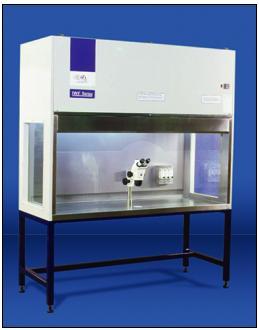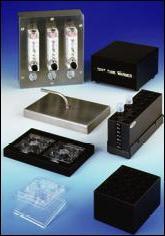IVF / ART Series - Laminar Flow Cabinets
Applications IVF/ART procedures for human and animal reproduction require a controlled work environment. Ultra-clean conditions are required to minimise microbial contamination in the aseptic handling of gametes and embryos. A warmed work surface is necessary to prevent thermal shock and, in most applications, provision for use of a microscope within the work zone is required. Clyde-Apac’s IVF Series laminar airflow cabinets satisfy these requirements. Description IVF Series cabinets are laminar flow workstations that are available with work zone width of 90cm, 120cm or 180cm. Internal work height of 80 cm allows effective and comfortable use of a wide range of stereo microscopes.The standard configuration supplied is a cabinet with a special floor stand, and this is the preferred arrangement. An optional configuration for installation on a normal laboratory bench is available, but this increases the internal work height to a point that may compromise ergonomics. Heated panels under the stainless
steel work surface maintain a temperature of 37.5°C with uniformity
within 1°C. The entire work surface is heated except for the perimeter,
with markings to delineate the heated area. A digital display mounted on
the cabinet control panel indicates the temperature, and an audible alarm
signifies any over-temperature condition. A penetration in the work surface
and a window for transmitted light allow fitting of a specific stereo microscope
that is provided by the cabinet user. The transmitted light source and
transformer are located underneath the work surface*. Typically, the microscope
Air cleanliness in the work zone is Class 3.5 (Class 100) and each cabinet is factory-tested and certified by a NATA-registered laboratory to establish compliance with the performance requirements of AS 1386, Part 5. Operation Vertical laminar flow in
the work zone creates a biologically clean, particle-free work environment.
A direct-drive fan draws in ambient air through a prefilter on the top
of the cabinet and supplies it to the work zone through a HEPA filter.
The average vertical air velocity in the work zone is maintained between
0.4 and 0.5 m/s, with all velocity readings within 20% of their average.
Air leaving the work zone is divided into two portions. Part of the airflow
leaves through the work opening, with the
Construction Cabinet
Fans
HEPA filters
Prefilters
Electrical
Standard features Heated work surface including electronic controller and digital display Mounting frame for light source and transformer Window for transmitted light Stainless steel work zone Partial airflow recirculation Low voltage touch controls Glare-free fluorescent lighting Prefilter service indicator
The following information is required when ordering a cabinet: The cabinet model (size) The location of the microscope penetration in the work surface – centre, RHS or LHS A full description of the specific microscope and light source (brand and model) that will be used Details of any accessories required Accessories and options Wheels fitted to floor stand Bench-mount cabinet configuration (work height is increased) Coloured fluorescent lighting, e.g. yellow Separate power outlet for microscope light source Gas flowmeters with regulating valve (specify number of meters required) Incubator gassing hood, stainless steel Warming blocks for follicular-fluid and culture tubes (with or without integral heating element) Warming blocks for culture dishes Personnel protection - limitations IVF cabinets provide protection for products or experiments, but do not protect personnel from aerosols of hazardous materials that may be handled in the cabinet. For applications where personnel protection is required, Clyde-Apac BH2000 Class II biological safety cabinets should be considered. *Further detail is available within the downloadable technical brochure and catalogue.
|


